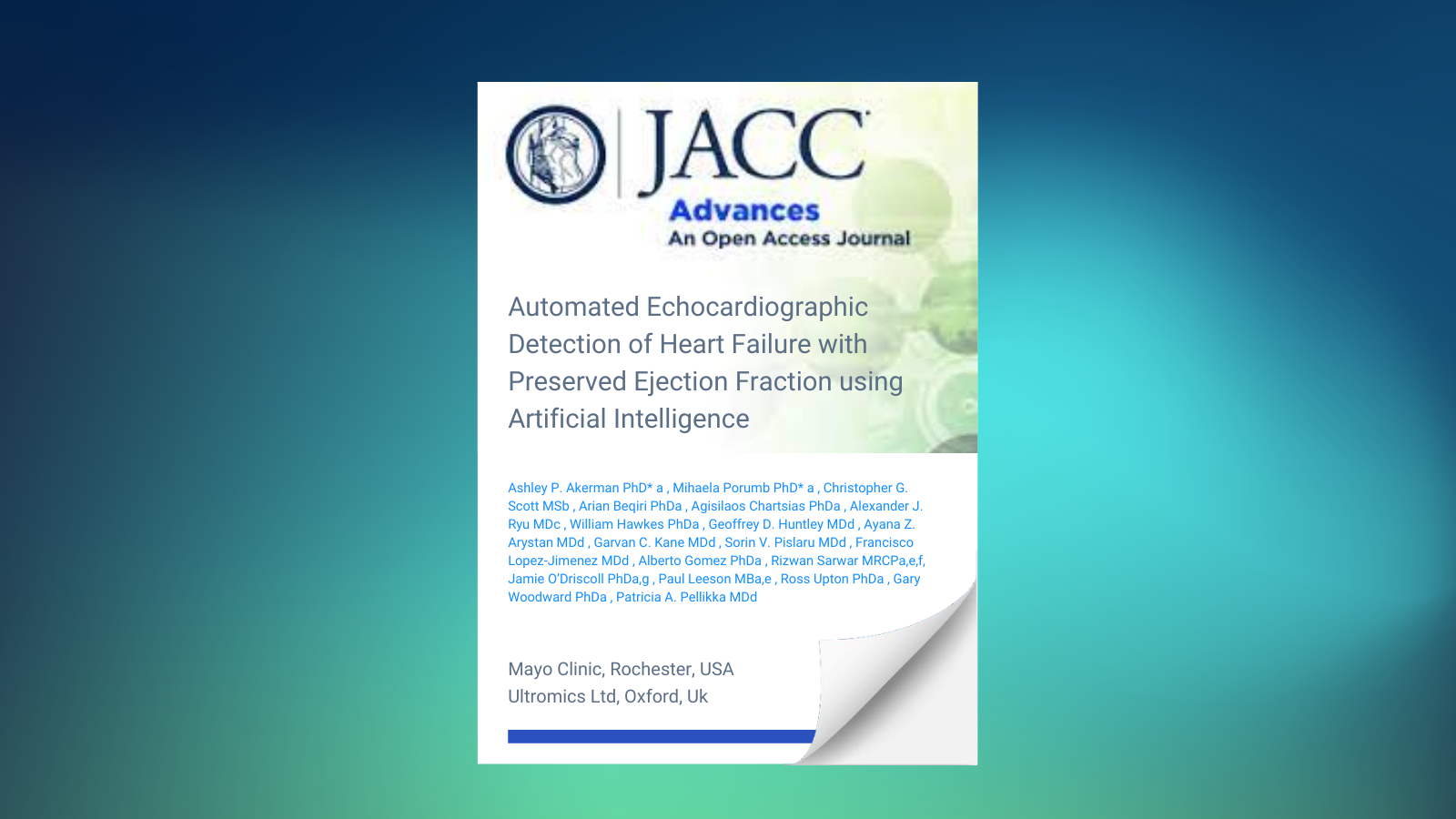
Automated Echocardiographic Detection of Heart Failure With Preserved Ejection Fraction Using Artificial Intelligence
- | By Ultromics
Ashley P. Akerman, Mihaela Porumb, Christopher G. Scott, Arian Beqiri, Agisilaos Chartsias, Alexander J. Ryu, William Hawkes, Geoffrey D. Huntley, Ayana Z. Arystan, Garvan C. Kane, Sorin V. Pislaru, Francisco Lopez-Jimenez, Alberto Gomez, Rizwan Sarwar, Jamie O'Driscoll, Paul Leeson, Ross Upton, Gary Woodward, and Patricia A. Pellikka
View the full publication here
 Background
Background
Detection of heart failure with preserved ejection fraction (HFpEF) involves integration of multiple imaging and clinical features which are often discordant or indeterminate.
Methods
A 3-dimensional convolutional neural network was developed and trained on apical 4-chamber video clips to classify patients with HFpEF (diagnosis of heart failure, ejection fraction ≥50%, and echocardiographic evidence of increased filling pressure; cases) vs without HFpEF (ejection fraction ≥50%, no diagnosis of heart failure, normal filling pressure; controls). Model outputs were classified as HFpEF, no HFpEF, or nondiagnostic (high uncertainty). Performance was assessed in an independent multisite data set and compared to previously validated clinical scores.
Results
Training and validation included 2,971 cases and 3,785 controls (validation holdout, 16.8% patients), and demonstrated excellent discrimination (area under receiver-operating characteristic curve: 0.97 [95% CI: 0.96-0.97] and 0.95 [95% CI: 0.93-0.96] in training and validation, respectively). In independent testing (646 cases, 638 controls), 94 (7.3%) were nondiagnostic; sensitivity (87.8%; 95% CI: 84.5%-90.9%) and specificity (81.9%; 95% CI: 78.2%-85.6%) were maintained in clinically relevant subgroups, with high repeatability and reproducibility. Of 701 and 776 indeterminate outputs from the Heart Failure Association-Pretest Assessment, Echocardiographic and Natriuretic Peptide Score, Functional Testing (HFA-PEFF), and Final Etiology and Heavy, Hypertensive, Atrial Fibrillation, Pulmonary Hypertension, Elder, and Filling Pressure (H2FPEF) scores, the AI HFpEF model correctly reclassified 73.5% and 73.6%, respectively. During follow-up (median: 2.3 [IQR: 0.5-5.6] years), 444 (34.6%) patients died; mortality was higher in patients classified as HFpEF by AI (HR: 1.9 [95% CI: 1.5-2.4]).

Central Illustration. Development and Testing of a Novel AI Model to Detect HFpEF From Single Echocardiographic Video Clips

Figure 1. Alluvial Plot Demonstrating Reclassification of Patients Using Clinical Scores Compared to the AI HFpEF Model
Conclusion
An AI HFpEF model based on a single, routinely acquired echocardiographic video demonstrated excellent discrimination of patients with vs without HFpEF, more often than clinical scores, and identified patients with higher mortality.
